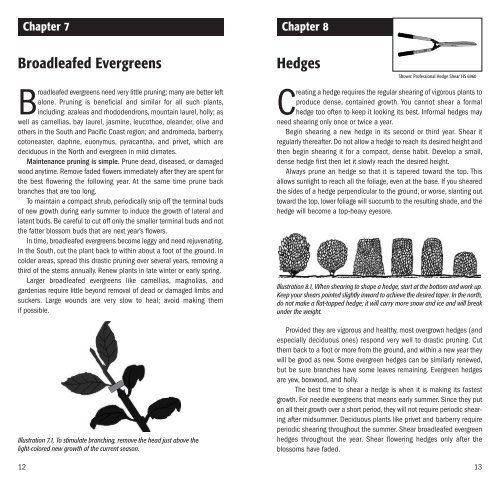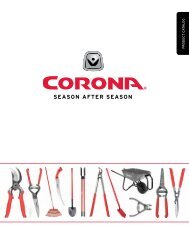Pruning Principles 2009 - Corona Tools
Pruning Principles 2009 - Corona Tools
Pruning Principles 2009 - Corona Tools
You also want an ePaper? Increase the reach of your titles
YUMPU automatically turns print PDFs into web optimized ePapers that Google loves.
Chapter 7<br />
Chapter 8<br />
Broadleafed Evergreens<br />
Hedges<br />
Shown: Professional Hedge Shear HS 6960<br />
Broadleafed evergreens need very little pruning; many are better left<br />
alone. <strong>Pruning</strong> is beneficial and similar for all such plants,<br />
including: azaleas and rhododendrons, mountain laurel, holly; as<br />
well as camellias, bay laurel, jasmine, leucothoe, oleander, olive and<br />
others in the South and Pacific Coast region; and andromeda, barberry,<br />
cotoneaster, daphne, euonymus, pyracantha, and privet, which are<br />
deciduous in the North and evergreen in mild climates.<br />
Maintenance pruning is simple. Prune dead, diseased, or damaged<br />
wood anytime. Remove faded flowers immediately after they are spent for<br />
the best flowering the following year. At the same time prune back<br />
branches that are too long.<br />
To maintain a compact shrub, periodically snip off the terminal buds<br />
of new growth during early summer to induce the growth of lateral and<br />
latent buds. Be careful to cut off only the smaller terminal buds and not<br />
the fatter blossom buds that are next year’s flowers.<br />
In time, broadleafed evergreens become leggy and need rejuvenating.<br />
In the South, cut the plant back to within about a foot of the ground. In<br />
colder areas, spread this drastic pruning over several years, removing a<br />
third of the stems annually. Renew plants in late winter or early spring.<br />
Larger broadleafed evergreens like camellias, magnolias, and<br />
gardenias require little beyond removal of dead or damaged limbs and<br />
suckers. Large wounds are very slow to heal; avoid making them<br />
if possible.<br />
Illustration 7.1, To stimulate branching, remove the head just above the<br />
light-colored new growth of the current season.<br />
12<br />
Creating a hedge requires the regular shearing of vigorous plants to<br />
produce dense, contained growth. You cannot shear a formal<br />
hedge too often to keep it looking its best. Informal hedges may<br />
need shearing only once or twice a year.<br />
Begin shearing a new hedge in its second or third year. Shear it<br />
regularly thereafter. Do not allow a hedge to reach its desired height and<br />
then begin shearing it for a compact, dense habit. Develop a small,<br />
dense hedge first then let it slowly reach the desired height.<br />
Always prune an hedge so that it is tapered toward the top. This<br />
allows sunlight to reach all the foliage, even at the base. If you sheared<br />
the sides of a hedge perpendicular to the ground, or worse, slanting out<br />
toward the top, lower foliage will succumb to the resulting shade, and the<br />
hedge will become a top-heavy eyesore.<br />
Illustration 8.1, When shearing to shape a hedge, start at the bottom and work up.<br />
Keep your shears pointed slightly inward to achieve the desired taper. In the north,<br />
do not make a flat-topped hedge; it will carry more snow and ice and will break<br />
under the weight.<br />
Provided they are vigorous and healthy, most overgrown hedges (and<br />
especially deciduous ones) respond very well to drastic pruning. Cut<br />
them back to a foot or more from the ground, and within a new year they<br />
will be good as new. Some evergreen hedges can be similarly renewed,<br />
but be sure branches have some leaves remaining. Evergreen hedges<br />
are yew, boxwood, and holly.<br />
The best time to shear a hedge is when it is making its fastest<br />
growth. For needle evergreens that means early summer. Since they put<br />
on all their growth over a short period, they will not require periodic shearing<br />
after midsummer. Deciduous plants like privet and barberry require<br />
periodic shearing throughout the summer. Shear broadleafed evergreen<br />
hedges throughout the year. Shear flowering hedges only after the<br />
blossoms have faded.<br />
13



